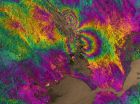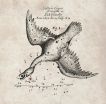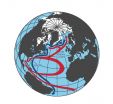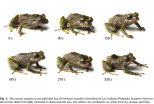(Press-News.org) When an earthquake hits, the faster first responders can get to an impacted area, the more likely infrastructure--and lives--can be saved.
New research from the University of Iowa, along with the United States Geological Survey (USGS), shows that GPS and satellite data can be used in a real-time, coordinated effort to fully characterize a fault line within 24 hours of an earthquake, ensuring that aid is delivered faster and more accurately than ever before.
Earth and Environmental Sciences assistant professor William Barnhart used GPS and satellite measurements from the magnitude 6.0 South Napa, California earthquake on August 24, 2014, to create a three-dimensional map of how the ground surface moved in response to the earthquake. The map was made without using traditional rapid response instruments, such as seismometers, which may not afford the same level of detail for similar events around the globe.
"By having the 3D knowledge of the earthquake itself, we can make predictions of the ground shaking, without instruments to record that ground shaking, and then can make estimates of what the human and infrastructure impacts will be-- in terms of both fatalities and dollars," Barnhart says.
The study, "Geodetic Constraints on the 2014 M 6.0 South Napa Earthquake" published in the March/April edition of Seismological Research Letters, is the first USGS example showing that GPS and satellite readings can be used as a tool to shorten earthquake response times.
And while information about an earthquake's impact might be immediately known in an area such as southern California, Barnhart says the technique will be most useful in the developing world. The catastrophic magnitude 7.0 earthquake that hit Haiti in 2010 is the perfect example for the usefulness of this kind of tool, Barnhart says. The earthquake struck right under the capital city of Port Au Prince, killing up to 316,000 people, depending on estimates, and costing billions of dollars in aid.
"On an international scale, it dramatically reduces the time between when an earthquake happens, when buildings start to fall down, and when aid starts to show up," Barnhart says.
To accurately map the South Napa earthquake for this study, Barnhart and a team of researchers created a complex comparison scenario.
They first used GPS and satellite readings to measure the very small- millimeter-to-centimeter-sized-displacements of the ground's surface that were caused by the earthquake. They fed those measurements into a mathematical equation that inverts the data and relates how much the ground moved to the degree of slip on the fault plane. Slip describes the amount, timing, and distribution of fault plane movement during an earthquake.
This allowed the group to determine the location, orientation, and dimensions of the entire fault without setting foot on the ground near the earthquake. The mathematical inversion gave the researchers predictions of how much the ground might be displaced, and they compared those results to their initial estimations, bit by bit, until their predictions and observations match. The resulting model is a 3D map of fault slip beneath the Earth's surface. The entire procedure takes only a few minutes to complete.
Nationally, there is a push to create an earthquake early-warning system, which is already being tested internally by the USGS in coordination with the University of California, Berkeley; the California Institute of Technology; and the University of Washington. While only researchers, first responders, and other officials received the early warning message, it did work in testing for the Bay Area during the Napa earthquake. Individuals in Berkeley received nearly 10 seconds of advanced warning before the ground began shaking. The information contained in Barnhart's study could be used to create further tools for predicting the economic and human tolls of earthquakes.
"That's why this is so important. It really was the chance to test all these tools that have been put into place," Barnhart says. "It happened in a perfect place, because now we're much more equipped for a bigger earthquake."
INFORMATION:
In addition to antiretroviral medications, people with HIV may soon begin receiving a home exercise plan from their doctors, according to a researcher at Case Western Reserve University's Frances Payne Bolton School of Nursing.
"People with HIV are developing secondary chronic illnesses earlier and more frequently than their non-HIV counterparts," said Allison Webel, PhD, RN, assistant professor of nursing. "And heart disease is one for which they are especially at risk."
An estimated 1.2 million people nationally live with HIV, according to the Centers for Disease ...
Today, ACS is launching its first open access multidisciplinary research journal. Aspiring to communicate the most novel and impactful science developments, ACS Central Science will feature peer-reviewed articles reporting on timely original research across chemistry and its allied sciences. Free to readers and authors alike, original research content will be accompanied by additional editorial features.
These additional editorial features include news stories contributed by the Society's award-winning science journalists, invited topical reviews (called Outlooks) from ...
Young children who received the 4CMenB vaccine as infants to protect against serogroup B meningococcal disease had waning immunity by age 5, even after receiving a booster at age 3 ½, according to new research in CMAJ (Canadian Medical Association Journal)
Serogroup B meningococcal disease is the leading cause of meningitis and blood infections in developed countries. Infants and young children under the age of 5 years are especially at risk, and there is a second peak of cases in the late teenage years.
The multicomponent serogroup B meningococcal (4CMenB) ...
COLUMBUS, Ohio--Researchers at The Ohio State University have discovered how to control heat with a magnetic field.
In the March 23 issue of the journal Nature Materials, they describe how a magnetic field roughly the size of a medical MRI reduced the amount of heat flowing through a semiconductor by 12 percent.
The study is the first ever to prove that acoustic phonons--the elemental particles that transmit both heat and sound--have magnetic properties.
"This adds a new dimension to our understanding of acoustic waves," said Joseph Heremans, Ohio Eminent Scholar ...
New observations made with APEX and other telescopes reveal that the star that European astronomers saw appear in the sky in 1670 was not a nova, but a much rarer, violent breed of stellar collision. It was spectacular enough to be easily seen with the naked eye during its first outburst, but the traces it left were so faint that very careful analysis using submillimetre telescopes was needed before the mystery could finally be unravelled more than 340 years later. The results appear online in the journal Nature on 23 March 2015.
Some of seventeenth century's greatest ...
New Haven, Conn. -- A Yale-led team has identified a promising new combination immunotherapy to enhance the body's ability to fight chronic viral infections and possibly cancer.
Their study was published March 23 in Nature Medicine.
Viruses that cause chronic infection, such as HIV and Hepatitis B and C, are able to persist in the body despite attack from T cells, the body's main line of defense against pathogens. They persist because, over time, our T cells weaken to the point of "T-cell exhaustion." To circumvent this process, the research team -- led by Susan Kaech, ...
Society should set a high carbon tax now to try and prevent climate change reaching a point of no return according to a new study.
The research, carried out by the Universities of Exeter, Zurich, Stanford and Chicago and published today in the journal Nature Climate Change shows that the prospect of an uncertain future tipping point should greatly increase the amount we are willing to pay now to limit climate change. Depending on the economic impacts of an abrupt change in climate and how quickly this is felt, the cost of carbon emitted now increases by 50 - 200%. Setting ...
The gradual but accelerating melting of the Greenland ice-sheet, caused by man-made global warming, is a possible major contributor to the slowdown. Further weakening could impact marine ecosystems and sea level as well as weather systems in the US and Europe.
"It is conspicuous that one specific area in the North Atlantic has been cooling in the past hundred years while the rest of the world heats up," says Stefan Rahmstorf of the Potsdam Institute for Climate Impact Research, lead author of the study to be published in Nature Climate Change. Previous research had already ...
Scientists have for the first time used DNA sequencing to trace the fatal spread of multidrug-resistant tuberculosis between patients in the UK.
Genetic analysis of the TB bacteria revealed how a 44-year-old man who died of the disease in 2012 caught the drug-resistant infection from a healthcare worker who had worked in South Africa, when both were admitted on the same medical ward four years earlier.
TB is spread by inhaling tiny airborne droplets from an infected person. The bacteria can survive in the lungs for long periods without causing symptoms - known as latent ...
A frog in Ecuador's western Andean cloud forest changes skin texture in minutes, appearing to mimic the texture it sits on.
Originally discovered by a Case Western Reserve University PhD student and her husband, a projects manager at Cleveland Metroparks' Natural Resources Division, the amphibian is believed to be the first known to have this shape-shifting capability.
But the new species, called Pristimantis mutabilis, or mutable rainfrog, has company. Colleagues working with the couple recently found that a known relative of the frog shares the same texture-changing ...



